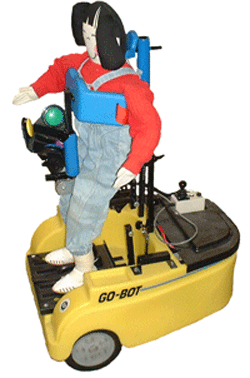
 |
 |
 |
 |
 |
 |
 |
 |
 |
 |
 |
 |
The Go-Bot Story

The Transitional
Powered Mobility Aid: TPMA
A New Concept and Tool
for Early Mobility
Christine
Wright-Ott, MPA, OTR
As a
pediatric occupational therapist, I had always been frustrated by the fact that
children with severe physical challenges had few opportunities for experiencing
self-initiated upright mobility during their early years. A time so critical for development was being
spent positioned in passive adaptive equipment or lying on the floor (where it
was hard to see the world around them or use their hands and arms to play). This is a real contrast to able-bodied peers
who, by 8-10 months of age, begin experiencing the rewards of self-initiated
upright mobility. My dream for children
with severe motor delays, such as those with cerebral palsy, was to provide them
with the opportunity to experience upright, self-initiated mobility, at as young
an age as possible, to augment their development. In order to achieve this, a new type of
mobility device was needed which would enable these children to move, get close
to objects for exploring and position them for experiencing gross motor play
activities such as pushing, pulling and kicking. A proposal by the Rehabilitation Engineering
Center at Lucile Salter Packard Children's Hospital at Stanford, to develop such
a device, known as the Transitional Power Mobility Aid (TPMA), was funded
through a grant from the U.S. Department of Education Office of Special
Education & Rehabilitative Services.
The
Transitional Power Mobility Aid (TPMA) or Go-Bot consists of a power base and an
adjustable positioning frame. The
control system, comprised of four switches or a joystick, can be positioned in
almost any location so the child can maneuver the TPMA by using movements of the
hands, head or feet. The frame can be
adjusted to position the child either in sitting, semi-standing or
standing. The most challenging aspect of
the project was designing a positioning frame to meet the following goals: can be easily adjusted to fit children from
12 months to 5 years of age, accommodates variations in physical abilities,
secures the child in an upright and desirable posture with a minimum of
restraints.
The
TPMA is not a powered wheelchair. It is
designed for indoor use or on level outdoor surfaces to promote exploratory or
"transitional" mobility experiences.
Transitional mobility is the precursor to functional mobility. It is the early learning stage when children
first begin to experience the consequences of self-initiated mobility. These experiences can "transition" them to a
more functional level of mobility, in which they can maneuver accurately and
efficiently from one place to another.
It is critical during the transitional phase that the children be allowed
the freedom to explore self-initiated mobility in an open space, which is also a
rewarding and positive experience.
Twenty
children were observed using the TPMA in 10, one hour sessions at a "Mobility
Day Camp." The children were from 15
months to 4 years of age. Observations
from the parents were noted and included longer naps, happier disposition, a
sudden increase in vocabulary and intelligibility, and an increase in eye
contact.
The goal of the TPMA is to enable a
course of development more equal to able bodied peers, by encouraging
exploration which will provide greater opportunities for development in the
areas of communication, vision, socialization, upper extremity function, and
self esteem. The TPMA design team,
Christine Wright-Ott, Margaret Barker and John Wadsworth, would like to thank
all those individuals who made this project possible, particularly the parents,
their children, teachers, aides and therapists for contributing their knowledge
and ideas during the development of the TPMA.
The
TPMA is sold as the Go-Bot and Mini-Bot by Innovative Products.
For further
information call 1-800-950-5185 or view the website at:
http://www.iphope.com/